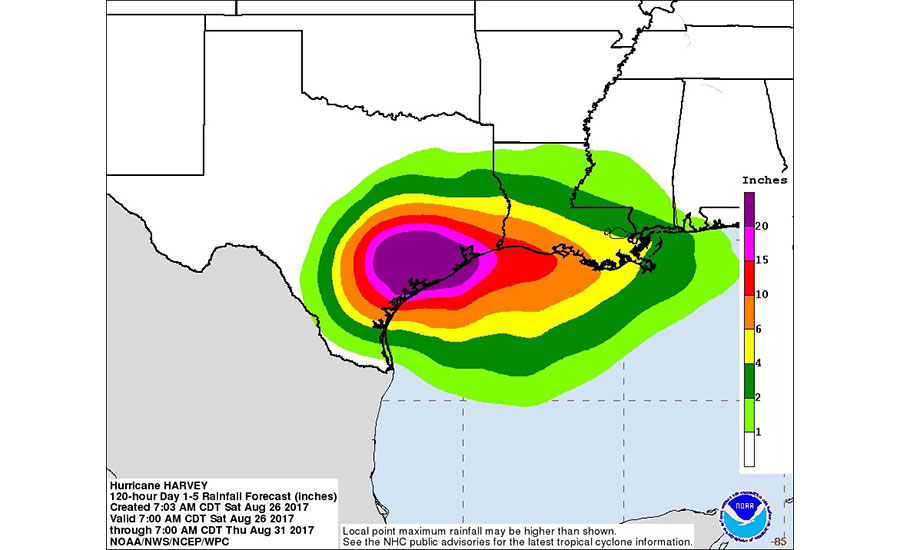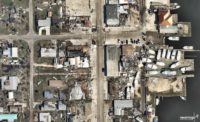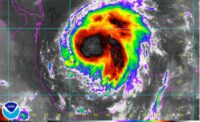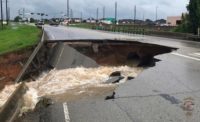Hurricane Downgraded, Expected to Become Tropical Storm
AUGUST 26, 8:50 a.m. CDT
Hurricane Harvey came ashore Friday night between Port Aransas and Port O'Connor, Texas, as a Category 4 storm with winds of 130 mph, the National Hurricane Center said. As storm winds dropped to 80 mph, the storm was categorized as a Category 1 storm, and was expected to become a Tropical Storm later Saturday. The National Hurricane Center, however, was still expecting up to 30 inches of rain over the next few days and warned of the risk of tornadoes.
More than 100,000 people were without power on Saturday morning, according to utility AEP. Texas DOT reported that Interstate 37 northbound was closed because of damage. It appears a sign bridge fell onto the roadway. — Pam Radtke Russell
Bechtel, Fluor Prepared, Monitoring Sites; Analyst Sees Fixed Price Project Risk
AUGUST 25, 4:30 p.m. CDT
Bechtel says it shut down construction at Cheniere Energy’s Corpus Christi liquefied natural gas facility on Aug. 24 and all other Bechtel projects along the Gulf Coast are closed. “Our project teams and Houston office have spent this week preparing for this weather event to ensure the sites and our colleagues are safe,” a company spokesman said.
Texas-based Fluor said its Sugar Land office remains open, and it is encouraging its employees to closely monitor the storm and take necessary precautions. “Project site decisions are being made on a case-by-case basis in coordination with clients. We will adjust as necessary as the storm progresses,” a company spokeswoman said.
In a note to investors on Aug. 25, Jamie Cook, lead construction and machinery analyst at Credit Suisse, said that Hurricane Harvey impacts could add to energy-construction sector investor caution related to "problem projects and lack of new awards," noting possible "incremental concerns with the risk of Hurricane Harvey threatening to hit the Gulf Coast, where there are a number of fixed priced contracts."
According to reports on the CNBC website, wind turbines in the Corpus Christi area, could "take a hit." Michael Cohen, head of energy markets research at Barclays, also told the network that hurricane flood impacts "could make it more destructive to US crude and product supplies as well as port facilities than the market is currently assuming."
— Pam Radtke Russell, Debra K. Rubin
One-fifth of Offshore Oil Shut-in as Storm Approaches
AUGUST 25, 2:35 p.m. CDT
Personnel have been evacuated off 89 offshore production platforms, or 11.67 % of the manned platforms in the Gulf of Mexico, according to the Bureau of Safety and Environmental Enforcement. People have also been evacuated from four of the 10 rigs operating in the Gulf, while one dynamically positioned rig has moved off location. BSEE estimates 21.55 % of the current oil production in the Gulf of Mexico has been shut-in, or 377,117 barrels of oil per day. It is also estimated that approximately 23.24 percent of the natural gas production, or 748 million cubic feet per day in the Gulf of Mexico has been shut-in. — Pam Radtke Russell
Center says Flooding, not Storm Surge, Big Risk with Harvey
AUGUST 25, 2:18 p.m. CDT
The storm surge impact to Texas’ shores should be slowed by the state’s barrier islands, Western Carolina University’s Program for the Study of Developed Shorelines says. But the area’s deepened navigational channels could cause problems, the center says:
“Many Texas barrier islands have dunes of significant enough height and volume to prevent over-topping by ocean surge. Where this is the case, the surge for areas inland of the immediate coast will be determined by how much water can make it over the low-lying portions of the barrier islands, and how much water can be pushed through the inlets. Of particular concern, are deepened navigational inlets like the Matagorda Ship Channel, because they provide an opportunity for large amounts of water to be pushed into the bay behind the barrier island. The area from Mustang Island and Port Aransas up to Sargent is of greatest concern because it will be to the right of the land-falling hurricane (therefore experiencing onshore winds) and because there are a number of navigational channels. This includes the highest risk for storm surge flooding in Aransas Bay, San Antonio Bay and especially Matagorda Bay.”
Rainfall and subsequent flooding will be the biggest problem, according to the center: “Suffice it to say that you can throw the existing flood maps out the window. They will under-predict the exposure to this event.” — Pam Radtke Russell
Harvey Storm Surge Army Corps Galveston Prepares for Harvey
AUGUST 25, 12:30 p.m. CDT
The Army Corps of Engineers' Galveston District is placing 850 ft of gabion bastions behind the pilings of a floodwall section under repair in Jefferson County, and along railroad tracks behind them. The county had identified the 600-ft-long compromised section on Aug. 1, with 200 ft of failure. Crews began placing 1,700 sandbags atop the filled scour hole last week.
Gabion bastions, super sandbags and other equipment are being added to coastal areas from Brownsville to Port Arthur.
The Addicks and Barker Dams, which provide flood risk reduction to the Houston area, are functional and ready to use, according to the Corps. The gates to the reservoirs will open to receive excess water if needed. The total capacity of the two earthen dams is 410,000 acre-ft.
The Houston airport system reports that almost 100 flights had been cancelled or delayed as of noon. To the north, Dallas-Fort Worth airport is prepared to host diverted flights and to serve as a resource for federal and state emergency management teams should the need arise, says a spokesperson.
Texas Dept. of Transportation began running courtesy patrol trucks along northbound I-37 between Corpus and SA Thursday night to help potentially stranded motorists. — Aileen Cho
Oil, Gas Production Stopped Ahead of Storm
AUGUST 24, 3:38 CDT
Companies are shutting down onshore and offshore oil production and refineries along the Texas coast are closing as Hurricane Harvey is expected to make landfall as a hurricane on Aug. 25. The state Bureau of Safety and Environmental Enforcement announced, as of Aug. 24, 11:30 CDT, that personnel had been evacuated from 39 energy producing platforms in the Gulf of Mexico, halting 10% of oil production, or 167,231 barrels of oil per day, and 14.66% of natural gas production, affecting an additional 472 million cu feet per day.
Statoil and ConocoPhillips also announced they were stopping onshore production in the Eagle Ford Shale region of Texas ahead of the storm.
Flint Hills and Citgo said they have shut down their refineries in Corpus Christi ahead of the storm. The storm is expected to make landfall near Corpus Christi. Refineries in Houston are considering shutting down also. — Pam Radtke Russell





Post a comment to this article
Report Abusive Comment